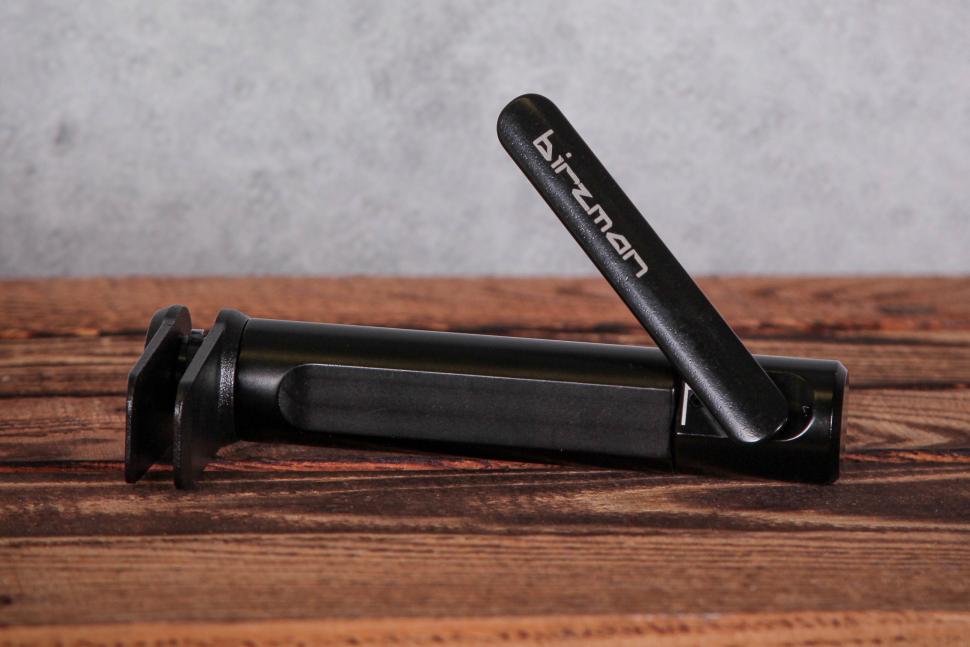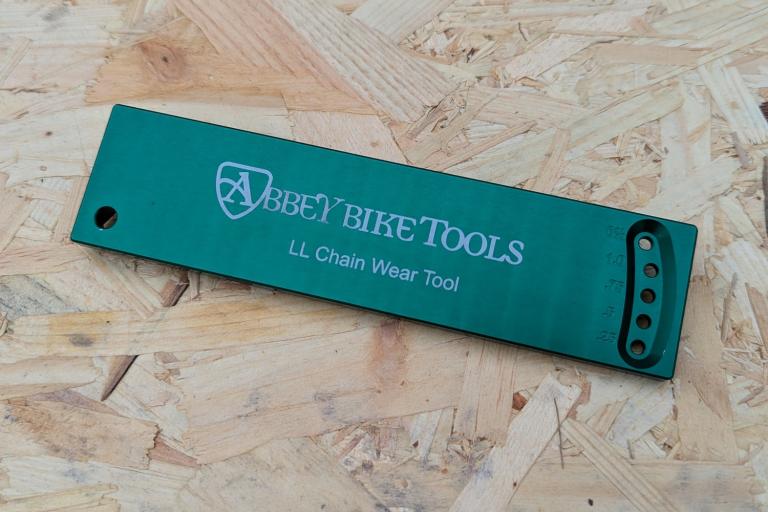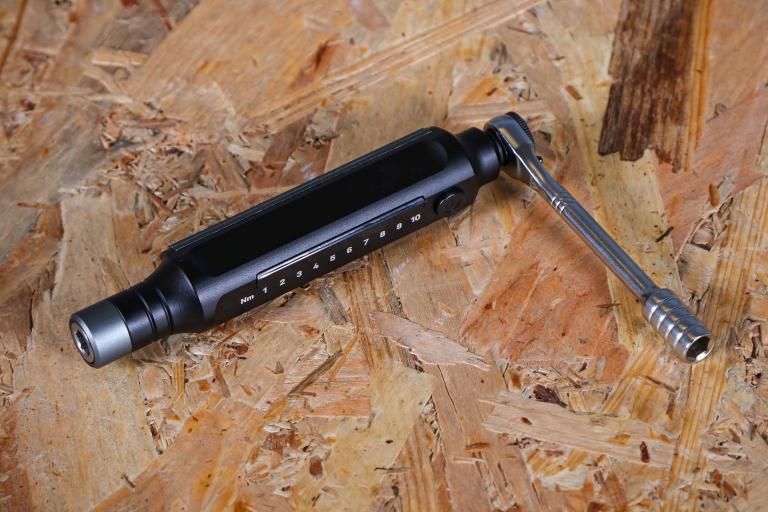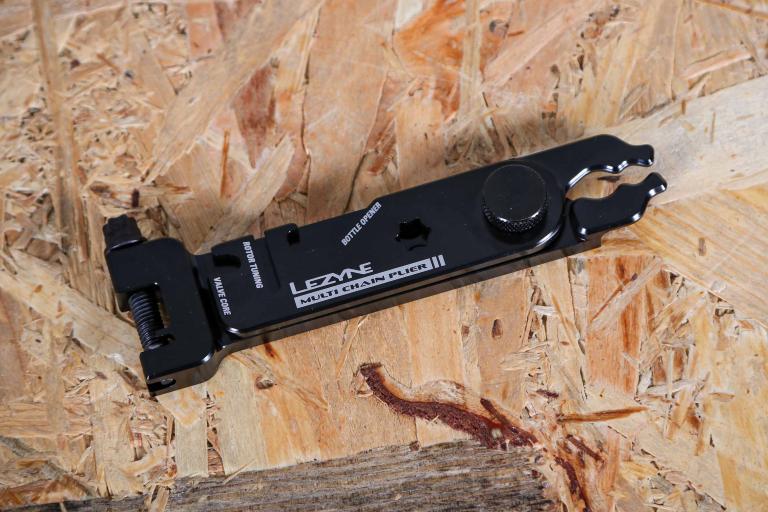- News
- Reviews
- Bikes
- Components
- Bar tape & grips
- Bottom brackets
- Brake & gear cables
- Brake & STI levers
- Brake pads & spares
- Brakes
- Cassettes & freewheels
- Chains
- Chainsets & chainrings
- Derailleurs - front
- Derailleurs - rear
- Forks
- Gear levers & shifters
- Groupsets
- Handlebars & extensions
- Headsets
- Hubs
- Inner tubes
- Pedals
- Quick releases & skewers
- Saddles
- Seatposts
- Stems
- Wheels
- Tyres
- Tubeless valves
- Accessories
- Accessories - misc
- Computer mounts
- Bags
- Bar ends
- Bike bags & cases
- Bottle cages
- Bottles
- Cameras
- Car racks
- Child seats
- Computers
- Glasses
- GPS units
- Helmets
- Lights - front
- Lights - rear
- Lights - sets
- Locks
- Mirrors
- Mudguards
- Racks
- Pumps & CO2 inflators
- Puncture kits
- Reflectives
- Smart watches
- Stands and racks
- Trailers
- Clothing
- Health, fitness and nutrition
- Tools and workshop
- Miscellaneous
- Buyers Guides
- Features
- Forum
- Recommends
- Podcast
review
 2022 Birzman Disc Brake Piston Pusher 1.jpg
2022 Birzman Disc Brake Piston Pusher 1.jpg£54.99
VERDICT:
Great idea that unfortunately is not delivered on by this tool in a reliable manner
Feels premium
Didn't work for most callipers
Difficult to get in place
Won't push four pistons squarely
Price
Weight:
213g
Contact:
At road.cc every product is thoroughly tested for as long as it takes to get a proper insight into how well it works. Our reviewers are experienced cyclists that we trust to be objective. While we strive to ensure that opinions expressed are backed up by facts, reviews are by their nature an informed opinion, not a definitive verdict. We don't intentionally try to break anything (except locks) but we do try to look for weak points in any design. The overall score is not just an average of the other scores: it reflects both a product's function and value – with value determined by how a product compares with items of similar spec, quality, and price.
What the road.cc scores meanGood scores are more common than bad, because fortunately good products are more common than bad.
- Exceptional
- Excellent
- Very Good
- Good
- Quite good
- Average
- Not so good
- Poor
- Bad
- Appalling
The Birzman Disc Brake Piston Pusher is designed to make the maintenance chore of replacing disc brake pads easier by pushing the pistons back into the calliper. Unfortunately, it fails to achieve those aims in a meaningful and replicable manner.
When replacing disc brake pads, it is essential to first clean inside the calliper to remove any mud or road contamination from around the piston edge, and then push the pads fully back into the calliper ready to accept the new pads. As you use your disc brake and the pads wear, over time the pistons don't retract back as fully as they had. This is an automatic adjustment feature, which means that you can use your pads from new all the way down to replacement, without ever needing to make any adjustments yourself.
The tried and trusted way to get your pistons pushed back into the calliper is to use a 10mm (or so) ring spanner or plastic tyre lever, carefully centring the closed end of the spanner or lever on the centre of the piston and leveraging against the side of the calliper to slowly push the piston back. Another option is a large flat-bladed screwdriver inserted between the worn pads, allowing the screwdriver to push back against a large surface area that you don't care about damaging.
You can buy specific flat tools from the likes of Park Tool and others that will push back pistons in a similar, more-couth fashion. But with care, the ring spanner or tyre lever method is perfectly acceptable and will cause no harm to your calliper.
Regardless of your chosen method, it's critical to thoroughly clean around the piston, so you aren't pushing muck back inside past the seal and into the chamber with the hydraulic fluid. Best suggestions for removing baked-on build-up include using a very fine bottle brush, or a section of cotton string soaked in alcohol and sawed back and forth around the piston while clamping two £1 coins.
The Birzman Disc Brake Piston Pusher seeks to do this job in an even more couth fashion than any sort of other hand tool. By applying force evenly to both pistons at the same time, it slowly pushes them back into the calliper using a handscrew mechanism that applies pressure to both pistons evenly. This means that if one piston is slightly stuck, both will be pushed back without having to chase back and forth between the free and recalcitrant pistons.
In theory this is an excellent idea, but in practice it doesn't work in a consistent manner.
Firstly, there's the issue of clearance. On a number of bikes I found it quite challenging to get the tool inserted cleanly between the pistons in a way that allowed the tool to push back squarely against them. This could be down to either calliper design, where there is a small key to guide new pads in place, or where there is a disc brake mount in the way, particularly in the case of rear callipers bolted closely into the frame. To be fair, in the instructions Birzman notes that for bottom-loading callipers the calliper will almost certainly need to be removed in order to gain clearance. For top-loading callipers it's generally easier to find a way to get the tool in between the pistons.
Secondly, Birzman states that this tool is suitable for four-pot callipers. Again, nice idea, but there is no way that this 23mm-wide tool can push back squarely against all four pistons at once.
Recently I tested the piston release tool from R3Pro, which I have had success in using not only to release stuck pistons, but also to push back a stuck or final piston in a four-pot calliper with care, using a thin, flat-bladed screwdriver.
Finally, even if you can get the tool cleanly inserted between two pistons, the force against the pistons does not end up being applied squarely, resulting in at least one if not both pistons going in slightly askew and almost certainly binding.
I thought this might be down to user error and tried many different combinations of calliper, angle and amount of pressure. I only managed to get one calliper with known-working-well pistons to retract back cleanly.
> Everything you need to know about disc brakes
A scour of internet forums threw up a few similar comments, where purchasers found the tool didn't manage to work as promised. To be fair to Birzman, there were a number of glowing recommendations where it did work.
Conclusion
Owning a bike servicing business, piston pushing is one of the most common tasks I have to perform in the workshop when replacing customers' brake pads. So when I saw the Birzman Disc Brake Piston Pusher, I was keen to get my hands on it and see if it could make what can become a time-consuming and frustrating job much easier and quicker. Unfortunately, the reality did not deliver on the promise, and therefore I cannot recommend this tool.
• As a matter of course when a product scores below average, we put our findings to the manufacturer to give them the right to reply.
Birzman says: "All of our products have of course been carefully tested on as wide a range of bikes/frames/parts as we could get our hands on during research and development stage, and we would only state the compatibility of a product if it has proven to work over various trials. It is our responsibility as the manufacturer to ensure the effectiveness of the product after all.
"At the same time, we are aware that due to the diverse specifications of bikes available on the market, there are inevitably limitations, mentioned by the reviewer, to the product when it comes to certain frame/brake designs where the product may not perform as well."
Birzman also says it will be releasing a new Double Ended Piston Pusher, due around September:
35 mm end for 4-piston callipers e.g. models from Shimano®/SRAM®/TRP®/Hope®
15 mm end for 2-piston callipers and callipers with unique structures e.g. Magura® MT5/7s
Verdict
Great idea that unfortunately is not delivered on by this tool in a reliable manner
road.cc test report
Make and model: Birzman Disc Brake Piston Pusher
Size tested: One size
Tell us what the product is for and who it's aimed at. What do the manufacturers say about it? How does that compare to your own feelings about it?
The product is designed for people wanting to replace their disc brake pads.
Birzman says: "Like a piston press, but doubled.
"Simultaneously presses pistons back into the calliper with parallel and symmetrically moving panels, the Disc Brake Piston Pusher is a handy tool that prepares the calliper for brake pad replacements."
Tell us some more about the technical aspects of the product?
Birzman lists these features:
Compatible with two- and four-piston brake callipers with an opening wider than 23mm.
Material
Aluminium 6061 / Alloy Steel
Size
Ø23 x 121mm
Weight
220g
Rate the product for quality of construction:
8/10
The quality of construction is extremely high, with fine tolerances and a lovely feel in the hand.
Rate the product for performance:
2/10
The performance is poor, as I only managed to push back a single pair of pistons cleanly.
Rate the product for durability:
8/10
The build quality does feel premium and I have no doubt that if it worked it would give many years of solid service.
Rate the product for value:
2/10
Given that the tool didn't work for most callipers tried, the price of £54.99 is exceedingly high.
Tell us how the product performed overall when used for its designed purpose
It does not achieve its designed purpose most of the time.
Tell us what you particularly liked about the product
The build quality.
Tell us what you particularly disliked about the product
The fact that it doesn't work for most callipers.
How does the price compare to that of similar products in the market, including ones recently tested on road.cc?
Compared with the Park Tool or other equivalent hand tools which I know work exceedingly well at this job and cost a fraction of the price, it is extremely expensive.
Did you enjoy using the product? Yes
Would you consider buying the product? No
Would you recommend the product to a friend? No
Use this box to explain your overall score
Given the tool only managed to push back one set of pistons cleanly, I cannot recommend it, and rate it accordingly.
About the tester
Age: 47
I usually ride: Sonder Camino Gravelaxe My best bike is: Nah bro that's it
I've been riding for: Over 20 years I ride: A few times a week I would class myself as: Expert
I regularly do the following types of riding: cyclo cross, general fitness riding, mtb, G-R-A-V-E-L
Living in the Highlands, Mike is constantly finding innovative and usually cold/wet ways to accelerate the degradation of cycling kit. At his happiest in a warm workshop holding an anodised tool of high repute, Mike's been taking bikes apart and (mostly) putting them back together for forty years. With a day job in global IT (he's not completely sure what that means either) and having run a boutique cycle service business on the side for a decade, bikes are his escape into the practical and life-changing for his customers.
Latest Comments
- thax1 4 hours 26 min ago
I don't consider myself a violent man, but I really don't think I'd tire of hitting him with a shovel. I mean, it'd take some pacing - I don't have...
- Laz 4 hours 27 min ago
OMG- that's so self centred....what about the brotherhood and sisterhood of enjoying a ride and sharing a happy wave with a fellow rider out...
- thax1 4 hours 54 min ago
Cycliq certainly seemed to let a lot of people down in the early days. I held off until the 12 Sport came out, but have been impressed....
- ktache 4 hours 56 min ago
My better half seems to like giving me pressies of Rapha clothing. I am wearing their casual hoodie right now, and very nice it is too. First off...
- thax1 5 hours 6 min ago
Push on through foot numbness and you then arrive at agonising foot cramp....
- ktache 5 hours 33 min ago
Not enough awareness as a driver to notice those 30mph limit roundels.
- Destroyer666 5 hours 43 min ago
Oh dear, to your own lack of understanding. I was not referring to your vague generalisation of "people", I was referring to a particular...
- chrisonabike 7 hours 5 min ago
Easy one that: it wasn't "so much traffic" before the cyclist was there! That queue had been building up behind the cyclist since the lane was...
- eburtthebike 7 hours 12 min ago
"It’s very expensive, I suspect, and I think it’s too much.”...
- lesterama 7 hours 31 min ago
Looks like he's risking riding without inserts. Didn't Fred Wright come a cropper in the Arenburg for the same reason?






Add new comment
62 comments
There is no doubt in my mind
None in mine, either. People are encouraged to continue cycling when they find they can stop in all conditions. There may be 'cons' to disk brakes for racers, but ordinary cyclists should send all this anti-disc hype to the same bin where the sensible consign all the anti-vax, anti-evolution by natural selection, moon landings faked in a studio etc. etc nutter misinformation. I seems to me that the racing teams having trouble with their top-end discs should save money by resorting to good quality cable discs which will be equal to,or better than, rim brakes- and give no trouble at all (hint: get TRP Spyes-no doubt other good cable discs are available)
What the hell has this got to do with fake moon landings or anti vax???
We are talking about inexperienced riders/mechanics who struggle to make disc brakes work properly without squeak or squawk etc..
You're on another planet!
It's quite simple if you actually read what you are replying to.
Don't forget the flat earth society - they are a very big organisation with members all around the globe.
Don't forget the truth deniers.
Mind you. A sprinkling (in the righ places) of a few grains of sand can seriously question their sanity.
Any under it though?
I've heard there's been some disunity in the organisation recently though, some of them feel they are poles apart…
I'm sure they'll all come round eventually long before going over the edge.
I discovered today that you need to add the Titanic to that list. Apparently it was a fake created by NASA !
I disagree. If you are the latter type of cyclist, you are probably get a bike shop to sort everything out for you, so the type of braking system makes no difference. I'd actually say it's someone more towards your former type of cyclist, but who isn't great at repairs/maintenance (the sort of person who'd mend a puncture and, yes, change rim brake pads, but wouldn't be sure about changing their chain or cassette or truing a wheel) who might be put off by disc brakes.
[Disclaimer - the latter is probably me, though I have changed chains/cassettes - and even so I'm happy to have switched to discs!]
<bike service business owner and former club captain here>
What gets people cycling more is consistent, safe and predictable braking in all weathers, on all surfaces.
What puts beople off - possibly for life - is being scared shitless when their brakes don't work in an emergency / in the wet.
If you don't know or care anything for bike maintenance, rim brakes are as alien as discs. Both you need to pay to have working properly.
Only one system is inherently poor in the wet / freezing temps, wears rims down over time, requires regular adjustment as pads wear, and requires good hand strength.
That's why discs are so popular, warts and all.
(word of advice: don't assume that just because people cycle lots, or even race pro, that they know how to or want to maintain their bikes. One of my most frequent customers can barely remove a rear wheel, yet rides an imperial century every few weeks).
Are you sure you're not from my LBS
In the current economic climate, many won't be able to afford to use their local LBS. Which is the point. And so the bike gets thrown into the grimy recesses of the shed.
Again, grimy disc brakes. Yikes!
Vicious circle.
It is what makes sites like this extremely useful. I've used the reviews to research parts/tools before spending my money. I've asked for advice and received lots - including plenty of cost saving tips. Just in this thread alone there is plenty of tips.
I am then passing this on to people at work who are interested in cycling. I've offered advice to the chap who keeps suffering punctures and shown another how to adjust his cabling to quieten down his gears and tighten his rim brakes.
It is never going to be as good as an expert, but it is enough to get them going again. I like to think they then share this knowledge on.
I will concede, however, your overall point - I do think the maintenance of bikes stops some people from cycling more. I have been very surprised at just how much maintenance is required to keep my bike going smoothly. All these people need is a friendly cyclist in their lives to nudge them along!
How do they profit?
What do you carry for your rim brakes ?
A bike shop is no stranger to the humble goal of turnover surplus over cost.
I have a set of Allen keys. That's it! Mostly for the bike itself. None of which have ever been necessary for any stick, squeal or squawk.
The first para doesn't answer the question nor explain what bike shops are doing extra over rims and how this generated profit.
Never had brake blocks squeal on a rim ? Never had a spring fail ?
Never spent 2 hours cleaning your rims with a Swiss stop rubber ?
I tried to use a Mavic Rubber to get rid of the glazing on my ceramic rims. Almost pointless. Shimano ceramic specific blocks. Less deposits when using SwissStop blues.
Was my only complaint with the ceramic XTR V brake set up, just lost the incredible bite of the first few rides, made it a little less likely of going over the bars though.
Obviously you don't know me, other than as a poster on here, but I don't moan about my disc brake performance.
Steve. I sympathise. When disc brakes grind down. It can grind you down.
Moaning doesn't solve disc brake issues. The moaning of piston on disc is enough for anybody.
Disc brakes don't grind me down. They also don't grind down the rims of my wheels. Nor the walls of my tyres, as a badly adjusted (yes, my fault) rim brake did and caused a blow out of a sharp downhill.
I think there is a divide of experience between those who commute and those who go on a long ride.
Commuting wore my rims down due to constant braking and all year, all weather commuting. Should have got less expensive wheels but didn't get the best advice when I got the bike.
Some of us do both, but yes, you are right that it's the commuting in all weathers that killed the rims.
I burned through a pair of Mavic Crossrides in four months.
Whatever you do, don't resort to simple disk brakes - you'll be so disheartened that you will give up cycling forever within days!
This whole 58-comment-and-counting thread on a rather disappointing tool exposes the reality of cycling: that the few try to dictate what the many should want, based on their own romantic world view.
Nine from you.
It's not that disappointing really, I won't be buying this based on your experience and review, the majority of the comments are based on braking technology, these discussions will rage on forever and I'll carry on with my Park Tool PP-1.2 on the 6 out of 11 bikes in my fleet with disc brakes (which I absolutely love BTW).
I'm curious as to what's in this "SOS kit" that's disc brake specific, and where I can get one. I'm horrified that I've been riding road disc since 2015 and could have been stranded at any time without the right kit. I'm just lucky that they've never given any problems in this time I suppose.
So I think this is an interesting question; I have recently been riding in central europe and I prefer to be self sufficient; so I carried spare pads (because they definitely wear very quickly) and a syringe attachement (because I figured I could probably find a syringe in a pharmacy, cut the end off the adaptor and cable tie it on, find a garage or a bike shop if im lucky and borrow some dot fluid to bleed using one end - if i was on mineral oil id probably carry that). i didnt carry a barb, olive or 8/10mm spanner; though I did consider them all; but I guess if i find a garage to borrow some dot, they'll have some spanners. I think if a hose goes youre just done.
On rim brakes i carried pads, cable and multitool and was 100% self sufficient
Pages